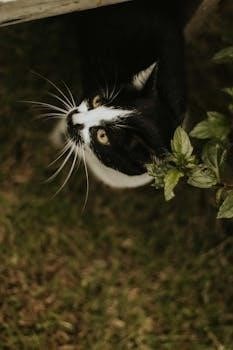the black cat story pdf
Overview of “The Black Cat” by Edgar Allan Poe
Edgar Allan Poe’s “The Black Cat,” published in 1843, is a chilling gothic tale told through a first-person narrative, exploring themes of insanity, superstition, and the destructive nature of alcoholism; It follows a man’s descent into madness.
First-Person Narrative and Gothic Genre
The story’s impact is heightened by its use of a first-person narrative, drawing readers into the narrator’s disturbed psyche and creating a sense of unease. This approach makes the reader question the narrator’s reliability, a key element of the gothic genre. “The Black Cat” is a prime example of gothic literature, utilizing dark themes, psychological horror, and elements of the supernatural, albeit ambiguously, to create a palpable atmosphere of dread and foreboding. This genre also explores the darker aspects of human nature, including violence and moral decay. The gothic nature of the story also allows for a focus on the disintegration of the soul and the destructive nature of unchecked impulses, further solidifying its place within the gothic tradition.
Themes of Insanity, Superstition, and Alcoholism
Poe masterfully intertwines the themes of insanity, superstition, and alcoholism throughout “The Black Cat”. The narrator’s descent into madness is a central focus, showcasing the deterioration of his mental state and his inability to control his violent impulses. Superstition is also a key element, with the black cat itself becoming a symbol of bad luck and the narrator’s growing paranoia. Alcoholism is presented as a catalyst for the narrator’s depravity, fueling his rage and making him increasingly unpredictable. The story highlights the destructive effects of alcohol abuse and its role in blurring the lines between reality and delusion and exacerbating the narrator’s descent into violence and terror. These themes combine to create a disturbing portrayal of a man consumed by his own demons.

Plot Summary and Key Events
The story follows a man’s disturbing transformation from an animal lover to a violent alcoholic. Key events include his brutal acts against his cat, Pluto, and subsequent descent into madness.
Narrator’s Early Life and Love for Animals
The narrator begins by recounting his childhood, emphasizing his gentle nature and profound love for animals. He describes himself as having a tender heart and a particular fondness for pets, which he had in abundance. This early depiction paints a picture of a kind and compassionate individual, a stark contrast to the violent figure he later becomes. His love for animals is presented as an inherent part of his character, a defining trait that makes his subsequent cruelty all the more shocking and disturbing to the reader, highlighting the drastic change he undergoes.
The Turning Point⁚ Narrator’s Descent into Violence
The narrator’s life takes a dark turn as he succumbs to alcoholism, which fuels his irritability and violent tendencies. This marks a significant shift from his earlier gentle nature. He begins to mistreat his wife and pets, with the black cat, Pluto, becoming a specific target of his cruelty. The act of gouging out Pluto’s eye is a pivotal moment, showcasing the narrator’s escalating brutality. This descent into violence reveals a disturbing transformation, highlighting the destructive power of alcohol and the deterioration of his moral compass, leading him further into madness and depravity.
The Second Cat and the Final Act of Horror
Following the gruesome murder of Pluto, a second black cat appears, bearing an uncanny resemblance to the first, except for a white patch on its chest. This new cat becomes a symbol of the narrator’s guilt and paranoia, further driving him towards the brink. In a fit of rage, triggered by the cat’s seemingly judgmental presence and the white patch he perceives as a gallows, the narrator attempts to kill the cat with an axe, but inadvertently murders his wife instead. This final act of horrific violence leads to the narrator’s eventual capture and confession, solidifying his descent into irreversible madness.

Analysis of Psychological Themes
Poe’s “The Black Cat” delves into the complex psychological themes of guilt, madness, moral decay, and the destructive effects of unchecked impulses and alcohol abuse, through the lens of an unreliable narrator.
The Narrator’s Unreliable Perspective and Self-Delusion
The narrator in “The Black Cat” presents a deeply unreliable perspective, constantly shifting between self-justification and moments of stark self-awareness. His narrative is warped by his alcoholism and descent into madness, making it difficult to discern truth from delusion. The story is a study in self-deception, as he attempts to rationalize his heinous actions, showcasing how his mind distorts reality to fit his twisted perceptions. This unreliability forces readers to question every aspect of his account, highlighting the dark power of self-delusion and the disintegration of reason.
Dual Personality and the Disintegration of the Soul
“The Black Cat” delves into the concept of a dual personality, showcasing the narrator’s transformation from a gentle animal lover to a violent abuser. This shift represents a profound disintegration of his soul, as his initial kindness is overtaken by a darker, more malevolent self. The narrator himself acknowledges this split, describing it as a breakdown of his very being. This duality highlights the internal conflict between good and evil, and the terrifying potential for the darker aspects of human nature to dominate. The story explores how these forces can lead to the complete destruction of an individual’s moral compass.

Guilt, Repression, and the Unconscious
The narrative of “The Black Cat” is heavily influenced by the themes of guilt, repression, and the unconscious. The narrator’s actions, driven by his alcoholism and violent impulses, generate intense feelings of guilt, which he attempts to repress. This repression, however, manifests in increasingly horrific acts. The story suggests that these repressed emotions do not simply disappear but fester within the unconscious mind, ultimately influencing the narrator’s behavior. The black cat itself might be seen as a symbol of these repressed feelings, constantly reminding him of his past transgressions, and highlighting the inescapable nature of his guilt.

Symbolism and Interpretation
“The Black Cat” is rich with symbolism, notably the cat itself, which represents the narrator’s inner demons. Alcoholism’s destructive effects and Freudian interpretations of the narrator’s actions are also significant.
The Black Cat as a Symbol of the Narrator’s Inner Demons
The black cat, initially named Pluto, functions as a potent symbol of the narrator’s deteriorating psyche and his repressed dark impulses. The cat’s initial bond with the narrator mirrors a semblance of the narrator’s former goodness, which is slowly corrupted by alcoholism and violence. As the narrator’s behavior becomes more erratic and malevolent, the cat transforms from a beloved pet into a representation of his inner demons, embodying guilt, perverseness, and the destructive forces within him. The cat’s missing eye reflects the narrator’s own blindness to his moral decay. The second cat further amplifies this symbolism, representing the inescapable nature of his guilt.
Alcoholism and its Destructive Effects
Alcoholism serves as a central catalyst for the narrator’s descent into violence and madness in “The Black Cat.” The story vividly portrays how alcohol consumption erodes the narrator’s initial gentle nature, transforming him into an abusive and erratic individual. His drinking fuels his irritability, leading to acts of cruelty against his pets, particularly Pluto, the black cat. This substance abuse not only destroys his relationships and moral compass but also unleashes a torrent of repressed aggression and inner turmoil. The narrative showcases how alcoholism distorts his perception of reality, blurring the lines between right and wrong, ultimately resulting in horrific consequences.
Freudian Interpretation of the Narrator’s Actions
From a Freudian perspective, the narrator’s actions in “The Black Cat” can be viewed as manifestations of repressed desires and internal conflicts. His cruelty towards the cat may represent a displacement of aggression stemming from unresolved psychological issues. The narrator’s violent behavior, especially when intoxicated, could be interpreted as the id taking over, revealing his primal instincts and hidden darkness. The act of walling up his wife might symbolize a desire to suppress the feminine aspect of his psyche. Ultimately, the story could be seen as an exploration of the human subconscious, with the narrator’s actions representing his struggle between his conscious and unconscious mind.

